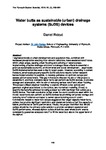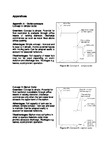Water butts as sustainable (urban) drainage systems (SuDS) devices
| dc.contributor.author | Ridout, D. | |
| dc.date.accessioned | 2019-07-24T11:21:22Z | |
| dc.date.available | 2019-07-24T11:21:22Z | |
| dc.date.issued | 2019 | |
| dc.identifier.citation |
Ridout, D. (2019) 'Water butts as sustainable (urban) drainage systems (SuDS) devices', The Plymouth Student Scientist, 12(1), p. 263-304. | en_US |
| dc.identifier.uri | http://hdl.handle.net/10026.1/14689 | |
| dc.description.abstract |
Heightened levels of urban development and population rise, combined with increased precipitation resulting from climatic variations, have escalated runoff rates within urban areas, causing urban flooding and polluting of watercourses. Implementing effective drainage solutions to manage these effects is essential to promote sustainable economic, environmental and social development. Larger-scale SuDS implementation has seen a rise in recent years. However, according to current literature, small-scale property-specific SuDS solutions require further research before implementation is possible, to develop guidance on optimum setups and assess performance levels. This gap in literature directed the aim of this project to determine if, and how, domestic water butts can perform as SuDS devices, to provide storage and attenuation, with the aim of reducing surface runoff and urban flooding. This project utilised physical modelling to explore different outlet options and generate original data related to the outlets, and numerical modelling (Excel) to quantify the benefits achieved by using a water butt with restricted flow outlets as a SuDS device. The main conclusion is that under the storm conditions used within the model, water butts can perform as SuDS devices by providing temporary storage and reducing runoff volumes conveyed to sewer systems during a storm event. Conclusions related to water butt setups suggested that larger capacity water butts, outlets that provide significant restriction, and drawdown levels at half the capacity or below, provide better SuDS performance. Finally, the project identified that simple outlets should be the primary outlet solution to provide consistent operation and SuDS performance, whereas siphon outlets should be used where storm events consistently guarantee adequate runoff to fill the water butt above the upper bend of the siphon. | en_US |
| dc.language.iso | en | en_US |
| dc.publisher | University of Plymouth | en_US |
| dc.rights | Attribution 3.0 United States | * |
| dc.rights.uri | http://creativecommons.org/licenses/by/3.0/us/ | * |
| dc.subject | sustainable urban drainage systems | en_US |
| dc.subject | SuDS devices | en_US |
| dc.subject | Water butts | en_US |
| dc.subject | runoff volumes | en_US |
| dc.subject | storm event | en_US |
| dc.title | Water butts as sustainable (urban) drainage systems (SuDS) devices | en_US |
| plymouth.issue | 1 | |
| plymouth.volume | 12 | |
| plymouth.journal | The Plymouth Student Scientist |




